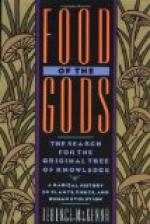“Notice shall be given by those who make chocolate for private families, and not for sale, three days before it is begun to be made, specifying the quantity, etc., and within three days after it is finished the person for whom it is made shall enter the whole quantity on oath, and have it duly stamped.”
Nothing is more eloquent of the growing favour in which cocoa is held in this country, as its real value becomes more generally appreciated, than the remarkable progressive increase of the quantities imported during recent years, as will be seen from the table appended. These quantities doubled between 1880 and 1890, and have since more than doubled again.
TABLE SHOWING THE QUANTITIES OF CACAO
CLEARED
FOR HOME CONSUMPTION SINCE 1880.
lbs. 1880 10,556,159 1881 10,897,795 1882 11,996,853 1883 12,868,170 1884 13,976,891 1885 14,595,168 1886 15,165,714 1887 15,873,698 1888 18,227,017 1889 18,464,164 1890 20,224,175 1891 21,599,860 1892 20,797,283 1893 20,874,995 1894 22,441,048 1895 24,484,502 1896 24,523,428 1897 27,852,152 1898 32,087,084 1899 34,013,812 1900 37,829,326 1901 42,353,724 1902 45,643,784
FOOTNOTES:
[18] Not an “Emperor,” as reported by his conquerors.
[19] See Appendix III.
[Illustration—Colour Plate: CHART SHOWING THE POSITIONS OF THE PRINCIPAL COCOA PLANTATIONS OF THE WORLD.]
V. ITS SOURCES AND VARIETIES.
[Illustration—Drawing: SACKS OF CACAO BEANS.]
Guayaquil, in the republic of Ecuador, on the west coast of South America, produces the largest output in the world. This cacao has a bold bean and a fine flavour, and is rich in theobromine; it is much valued on the market, and its strength and character render it indispensable to the manufacturer.
The neighbouring countries of Columbia and Venezuela, facing the Caribbean Sea, have for centuries grown cacao of excellent quality. The criollo (creole) bean is generally used as seed, and for it high prices are obtained. Owing, however, to the unsettled state of the republics and their unstable governments, its cultivation has gone back rather than forward during the past decade. With better administration and settled peace, great developments might easily be achieved. The British Royal Mail Steam Packet Company provides a good fortnightly service to England.
In early times the Jesuit missionaries encouraged the natives to form small plantations on the borders of the river Orinoco, and Father Gumilla, in his “History of the Orinoco,” says: “I have seen in these plains forests of wild cacao-trees, laden with bunches of pods, supplying food to an infinite multitude of monkeys, squirrels, parrots, and other animals.”




